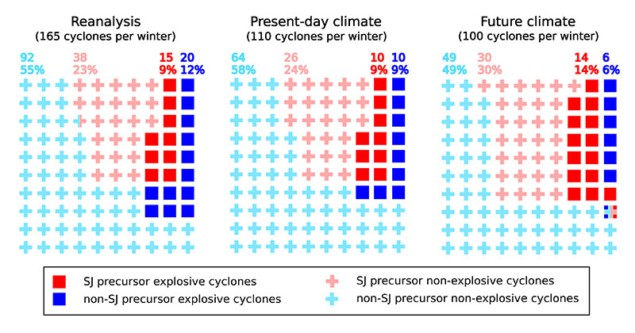
A warming climate could worsen European windstorms. That’s according to models that show the proportion of explosively-developing weather systems with sting-jets increasing by 60%. Sting-jets – transient jets of air descending from cloud level – boost wind speeds near the ground and increase the amount of damage caused by storms.
“Our results warn that if we allow climate change to continue unchallenged, European cities are likely to suffer more frequently the devastating effects of high winds, including storm surges in coastal areas,” said Oscar Martinez-Alvarado from the UK’s National Centre for Atmospheric Science. “However, an important detail about our study is that we assumed the most extreme climate change scenario in which the concentration of greenhouse gases keeps increasing throughout the 21st century.”
The team hopes that actions to tackle rising global surface temperatures such as targets on reducing greenhouse gas emissions will mean better news for Europe’s weather.
Advances in computing power allow researchers to explore weather systems – such as the extra-tropical cyclones that dominate autumn and winter weather over Western Europe – in more detail than ever before. But sting jets are particularly challenging for climate modellers to capture.
“They are relatively small-scale features, only a few hundreds of kilometres wide, and therefore can only start to be realistically resolved in models with a horizontal grid spacing of around 12 km,” said Martinez-Alvarado. “However, typical climate models work with horizontal grid spacings of around 60 km.”
To reduce the computational burden, the team inferred the likelihood of sting-jet occurrence indirectly, using precursors.
“In previous work, we showed that sting jets are associated with the occurrence of a certain type of instability in the atmosphere, which would manifest itself as the downward motion of air forming (or enhancing) a sting jet,” said Martinez-Alvarado.
Applying their proven sting-jet diagnostic to present day results, the scientists found that 32% of cyclones exhibited the precursor. When they modelled climate behaviour out to the year 2100, the figure rose to 45%.
“We believe that this increase is due to the enhanced availability of moisture in a warmer climate, but more work is needed to confirm this hypothesis,” said Martinez-Alvarado.
In addition, the group, including scientists based at the University of Reading, the University of Oxford and the UK’s Met Office, is keen to know more about the nature of the energy transport process. In other words, by what mechanisms the energy of sting jets, which are present 1 to 2 km above sea level, reaches the ground.
The team published the results in Environmental Research Letters (ERL).



